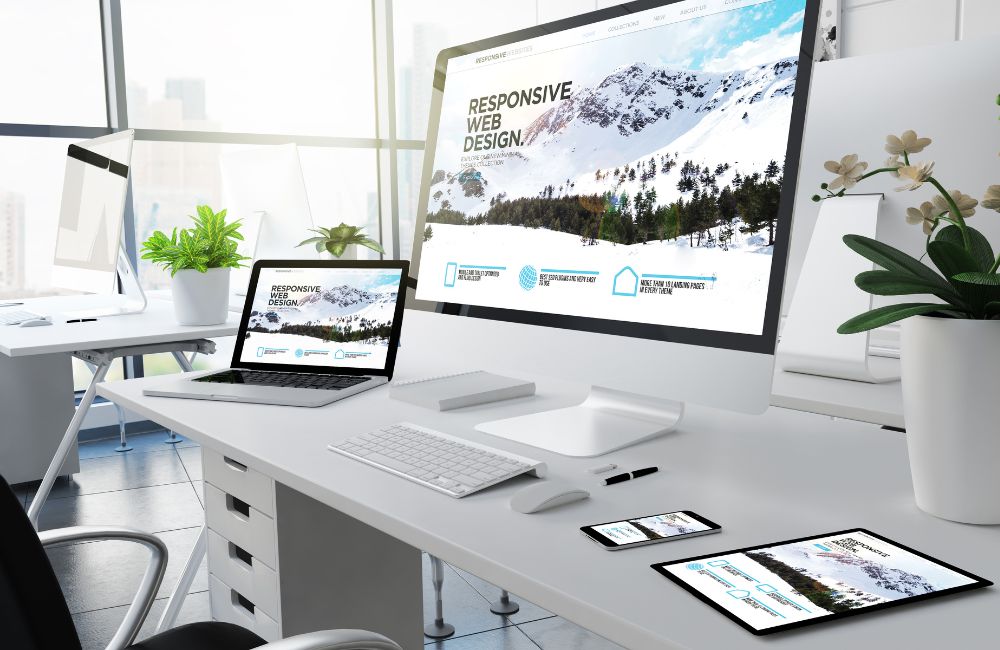- Free Estimates

Key Takeaways
|
Your website often serves as the first impression for potential customers, making it a vital aspect of your brand. Research shows that people make quick judgements on your business credibility based on your website’s design. But when it comes to building a website, business owners face a fundamental question: should they invest in a custom web design or opt for a website template?
Each option has its own set of advantages and drawbacks, and the right choice depends on various factors, including your business goals, budget, and technical expertise. This blog aims to explore both options in depth, providing a comprehensive guide to help you make an informed decision.

Custom web design is a process that involves creating a unique website from the ground up, tailored specifically to meet the unique needs of a business. This approach is not just about aesthetics; it’s about crafting a digital experience that aligns perfectly with your brand’s identity and goals. A web design company specializing in custom solutions works closely with clients to understand their vision, objectives, and target audience, ensuring that every element of the website is designed to support these aspects.
A custom web design offers a unique appearance that reflects the brand’s personality and ethos. This is achieved through bespoke visual elements, including layout, color schemes, typography, and imagery, all designed to resonate with the target audience and distinguish the brand from competitors.
Custom web design allows for the development of specific features and functionalities that cater to the unique requirements of a business. This could include anything from a tailored e-commerce platform to custom user interfaces or bespoke content management systems (CMS). A web design company can integrate advanced features such as interactive maps, custom forms, or integration with other software solutions, providing a seamless user experience.
Custom websites are built with scalability in mind, which means they can evolve as a business grows. A web design company can design the architecture of the website to accommodate future additions or changes, such as new service offerings, expanded content sections, or enhanced interactive elements. This flexibility ensures that the website remains relevant and functional as the business landscape changes.
The primary advantage of custom web design is the ability to create a website that is entirely unique. Unlike templates, which may limit creativity and customization, a custom site can reflect the business’s specific branding, providing a distinctive look and feel that sets it apart in the marketplace. This uniqueness is essential for businesses looking to establish a strong brand identity.
Custom websites can be built with specific features that are crucial for business operations. For instance, an e-commerce business may require custom checkout processes, while a service provider might need a complex booking system. A web design company can develop these features to ensure they work seamlessly and enhance the overall functionality of the site.
Custom websites can be optimized more effectively for search engines, enhancing their visibility and attracting more traffic. A web design company can implement SEO best practices from the outset, including optimizing site architecture, coding standards, and content structure. This proactive approach can lead to better search engine rankings and increased online visibility.
A custom web design allows for a tailored user experience which means a web design company can create a site layout and navigation that aligns perfectly with the needs and preferences of their audience. This customization can lead to higher conversion rates by up to 400% and better user satisfaction. A web design company can also use data and analytics to refine the UX, ensuring that users can easily find the information they need and perform desired actions, such as making a purchase or contacting the company.
One of the main drawbacks of custom web design is the higher initial cost. Creating a website from scratch requires significant investment in terms of time and money. This is because a web design company must allocate resources to design, development, testing, and optimization, which can be costly.
Building a custom website is a complex process that can take several months, depending on the project’s scope and complexity. This extended timeline is necessary to ensure that every aspect of the site is carefully crafted and tested. For businesses needing a quick online presence, this time investment may not be feasible.
Custom websites may require regular updates and maintenance to keep up with technological advancements and security needs. This ongoing requirement can add to the overall cost and requires a commitment to long-term upkeep, which may involve working closely with a web design company or hiring in-house technical staff.
Website templates are pre-designed website layouts that can be customized to a certain extent. They provide a quick and cost-effective way to establish an online presence by allowing users to choose from a range of designs and modify them with their own content and branding elements. Many web design companies offer template-based services as a more affordable alternative to custom web design.
Templates come with pre-set designs that define the structure and appearance of the website. Users can select from a variety of styles and themes, which can be customized by changing colors, fonts, images, and text. This provides a straightforward solution for businesses that need a functional website without investing in a fully custom design.
While templates offer some level of customization, they are generally limited in how much they can be altered. The core structure and features are set, which means businesses can only modify superficial elements like colors and fonts. For companies with specific needs, these limitations can be a significant drawback.
Templates are designed to be user-friendly, making them accessible even to those with little to no technical skills. Most templates come with drag-and-drop editors and other intuitive tools that simplify the customization process. This ease of use makes templates an attractive option for small businesses or startups looking to establish a web presence quickly and affordably.
One of the biggest advantages of using a website template is the lower initial cost. Templates are much cheaper than custom designs because they are pre-made and only require minor customization. This cost-effectiveness makes templates an appealing option for businesses with limited budgets.
With a template, businesses can get their website up and running quickly. Since the design and layout are already created, the primary task is to input content and make minor adjustments. This can often be done in a matter of days, making templates a good choice for businesses that need a rapid launch.
Many templates are designed for ease of use, offering features like drag-and-drop functionality and easy-to-navigate interfaces. This user-friendliness makes it possible for business owners to set up and manage their websites without needing to hire a web design company or technical experts.
Because templates are used by many businesses, websites built with them can lack a unique identity. This can be a significant disadvantage for companies looking to stand out in a crowded market. The standardized design means that a template-based website may look similar to many others, which can dilute brand differentiation.
Templates might not be optimized for all browsers and devices, potentially affecting site performance. Since they are built to accommodate a wide range of users, they may include unnecessary features or code, leading to slower load times. A web design company may need to optimize the template further, adding to the costs and time required.
As a business grows, the limitations of a template may become apparent. Templates are not typically designed with scalability in mind, which means adding new features or significantly altering the site’s layout can be challenging. This lack of flexibility may eventually necessitate a complete redesign, potentially involving a web design company for a more custom solution.

Choosing between custom web design and website templates is a significant decision for any business. Both options have distinct advantages and disadvantages, and the right choice depends on your specific business needs, goals, and resources. A web design company can provide valuable insights to help you navigate these options. Below is a detailed comparison of the key aspects to consider when making this decision.
Custom Web Design | Website Templates | |
Design Flexibility and Uniqueness | Highly flexible and unique, tailored to your brand. | Limited customization, often resulting in similar-looking sites. |
Performance and SEO | Optimized for fast load times and SEO, enhancing visibility. | May not be as optimized, potentially impacting speed and SEO. |
User Experience (UX) and User Interface (UI) | Tailored user experience, leading to higher engagement and satisfaction. | Standardized experience, may not fully meet specific audience needs. |
Security and Maintenance | Advanced security features, requires regular updates and maintenance. | Generally secure but can be vulnerable if not updated, especially if widely used. |
Scalability and Future Growth | Designed to grow with your business, flexible for future changes. | Limited in scalability, may require a redesign as your business grows. |
Cost | Higher due to custom development and unique features. | Lower, as it uses pre-designed templates with basic features. |
Lorem ipsum dolor sit amet, consectetur adipiscing elit. Ut elit tellus, luctus nec ullamcorper mattis, pulvinar dapibus leo.
Begin by identifying your specific business goals and objectives. Determine whether your website needs unique features such as custom e-commerce systems or specialized user interactions. If your needs are complex, a custom web design, crafted by a web design company, is likely the best choice. For simpler requirements, a template can provide a sufficient solution.
Establish a realistic budget for your website project. Consider both initial costs and ongoing expenses like maintenance, updates, and potential redesigns. Custom web design generally requires a higher upfront investment but offers long-term benefits. Templates are more budget-friendly initially but may incur additional costs for customization and scaling.
Evaluate your project timeline. If you need to launch your website quickly, templates can be implemented faster. Custom web design, while taking longer, provides a more tailored solution. Work with a web design company to determine the best timeline for your specific needs.
Examine the technical skills and resources available within your team. Custom websites often need a team of skilled developers and ongoing support, which can be provided by a web design company. Templates are designed for ease of use and require less technical expertise, making them suitable for businesses with limited resources.
Think about your long-term vision for the website. If you anticipate significant growth or need to add complex features in the future, a custom website offers the necessary flexibility and scalability. A web design company can help ensure your website evolves with your business needs.
Research and select the right web design company or partner. Whether you choose a custom design or a template, it’s crucial to find a web design company with a proven track record. Review portfolios and client testimonials to ensure they can deliver the quality and functionality you need.

Yes, custom web design can significantly enhance accessibility by adhering to standards such as the Web Content Accessibility Guidelines (WCAG). A professional web design company can implement features like screen reader compatibility, keyboard navigation, and alt text for images, ensuring your website is accessible to all users, including those with disabilities.
Yes, it is possible to migrate from a template to a custom design. However, this process can be complex and time-consuming, especially if the existing content and functionality need significant adjustments. It’s crucial to work with a skilled web design company to ensure a smooth transition and minimize downtime.
While website templates generally have lower upfront costs, there can be hidden expenses such as purchasing premium plugins, themes, or extended support. Additionally, as a business grows, the need for customization or template modifications might require hiring a developer, leading to unforeseen costs.
Templates often require updates to maintain compatibility with new web standards, security protocols, and browsers. While some template providers offer free updates, others may charge for extended support. It’s essential to consider these factors when choosing a template, as outdated templates can pose security risks and compatibility issues.
Custom web design offers greater flexibility in integrating with third-party services such as CRM systems, payment gateways, and analytics tools. A web design company can tailor these integrations to your specific requirements, ensuring seamless functionality. Templates may have limited support for such integrations, potentially requiring additional customization.

Choosing the right web design company is crucial for creating a site that stands out and drives business growth. Our team understands the unique market dynamics of Charlotte, NC, and tailors each project to meet the specific needs and goals of our clients. Whether you’re looking for a sleek, modern design or a more classic, professional look, our web design company delivers high-quality, scalable websites that not only look great but also perform exceptionally well.
Let the best Website Design Company in Charlotte, NC, be your trusted partner in building a powerful online presence that truly reflects your brand’s identity and values.